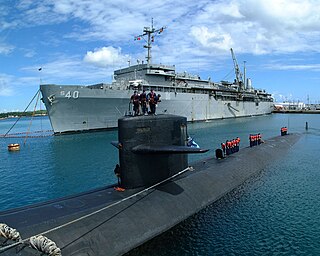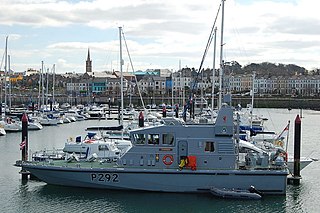Ten ships of the Royal Navy have been named HMS Hermes, after Hermes, the messenger god of Greek mythology, while another was planned:

USS Charger (CVE-30) was an escort carrier of the United States Navy during World War II.

A submarine tender is a type of depot ship that supplies and supports submarines.

The Tacoma class of patrol frigates served in the United States Navy during World War II and the Korean War. Originally classified as gunboats (PG), they were reclassified as patrol frigates (PF) on 15 April 1943. The class is named for its lead ship, Tacoma, a Maritime Commission (MARCOM) S2-S2-AQ1 design, which in turn was named for the city of Tacoma, Washington. Twenty-one ships were transferred to the British Royal Navy, in which they were known as Colony-class frigates, and twenty-eight ships were transferred under Lend-Lease to the Soviet Navy, where they were designated as storozhevoi korabl, during World War II. All Tacoma-class ships in US service during World War II were manned by United States Coast Guard crews. Tacoma-class ships were transferred to the United States Coast Guard and various navies post-World War II.

The Captain class was the designation given to 78 frigates of the Royal Navy, constructed in the United States of America, launched in 1942–1943 and delivered to the United Kingdom under the provisions of the Lend-Lease agreement. They were drawn from two sub-classes of the American destroyer escort classification: 32 from the Evarts subclass and 46 from the Buckley subclass. Upon reaching the UK the ships were substantially modified by the Royal Navy, making them distinct from the US Navy destroyer escort ships.

The Avenger-class escort carrier was a class of escort carriers comprising three ships in service with the Royal Navy during the Second World War and one ship of the class in the United States Navy called the Charger Type of 1942-class escort carrier. All three were originally American type C3 merchant ships in the process of being built at the Sun Shipbuilding and Drydock Company Chester, Pennsylvania. The ships laid down in 1939 and 1940 were launched and delivered to the Royal Navy by 1942 under the Lend-Lease agreement.

HMS Wellington is a Grimsby-class sloop, formerly of the Royal Navy. During the Second World War, she served as a convoy escort ship in the North Atlantic. She is now moored alongside the Victoria Embankment, at Temple Pier, on the River Thames in London, England, as the headquarters ship of the Honourable Company of Master Mariners, where she is known as HQSWellington. It was always the ambition of the founding members of the company to have a livery hall. Up to the outbreak of war in 1939, various proposals were examined, including the purchase of a sailing ship, Archibald Russell.

HMS Charger is an Archer-class patrol vessel built by Watercraft Limited, Shoreham-by-Sea and fitted out at Vosper Thornycroft. She is just over 20 metres long and 5.8 metres wide and powered by two Rolls-Royce turbo engines. The ship is based at the Royal Naval Headquarters (Merseyside) in Liverpool and was commissioned in 1988. She has five full-time RN crew, and sails with an RNR training officer and a maximum complement of 12 students. She is attached to the Liverpool University Royal Naval Unit.

HMS Cosby was a Buckley-class Captain-class frigate during World War II, it was named after Captain Phillips Cosby (1727–1808) of HMS Robust during the American Revolutionary War.
HMS Deane was a Captain class frigate of the Buckley class of destroyer escort, originally commissioned to be built for the U.S. Navy. Before she was finished in 1943, she was transferred to the Royal Navy under the terms of Lend-Lease, and saw service during World War II.

The Royal Navy has had a presence in Liverpool & Merseyside area for hundreds of years in varying formats. This article regards the reserves training taking place at HMS Eaglet. The unit trains local men & women for a variety of roles in the Royal Naval Reserve. In addition to housing a number of other naval units & roles within the establishment, including but not limited to: Royal Marine Reserves Merseyside, NRCNE, Liverpool URNU, HMS Biter, HMS Charger, Local Sea Cadet Corps & ACLO functions.

The Gay class were a class of twelve fast patrol boats that served with the Royal Navy from the early 1950s. All were named after types of soldiers or military or related figures, prefixed with 'Gay'. The class could be fitted as either motor gun boats or motor torpedo boats, depending on the type of armament they carried.
HMS Dittany was a Flower-class corvette of the Royal Navy during the Second World War.
HMS Dakins (K550) was a Captain-class frigate of the Royal Navy during the Second World War. Built as a Buckley-class destroyer escort intended for the United States Navy, she was transferred to the Royal Navy in 1943 under the terms of Lend-Lease.

HMS Trollope (K575) was a British Captain class frigate of the Royal Navy in commission during World War II. Originally constructed as a United States Navy Buckley class destroyer escort, she served in the Royal Navy from January to July 1944, when she was lost.

HMS Inman (K471) was a Captain-class frigate of the Royal Navy in commission in World War II. Originally built as the United States Navy Evarts-class destroyer escort DE-526, she served in the Royal Navy from 1944 to 1945.
HMS Cuckmere (K264) was a River-class frigate of the Royal Navy (RN) in 1943. Cuckmere was originally to be built for the United States Navy, having been laid down as PG-104, but was transferred to the Royal Navy as part of Lend-Lease and finished to the RN's specifications as a Group II River-class frigate. She was first Royal Navy ship to carry the name Cuckmere.
This page is based on this
Wikipedia article Text is available under the
CC BY-SA 4.0 license; additional terms may apply.
Images, videos and audio are available under their respective licenses.










